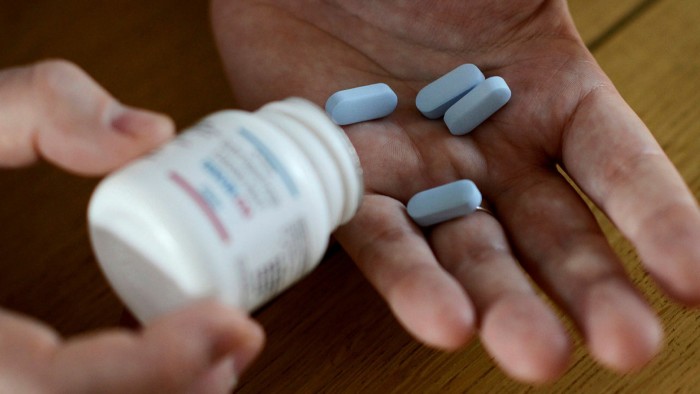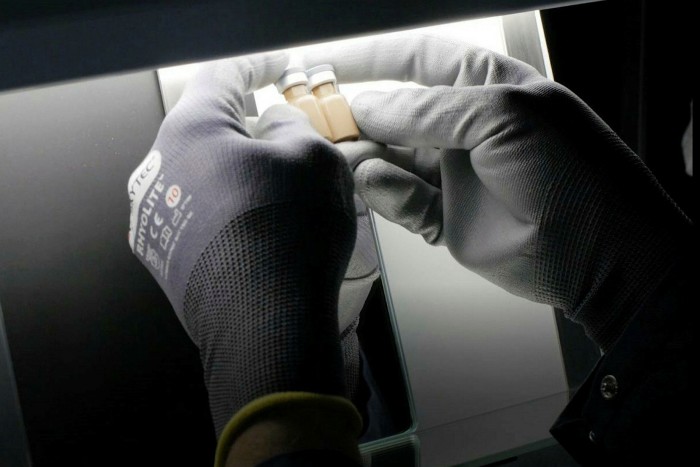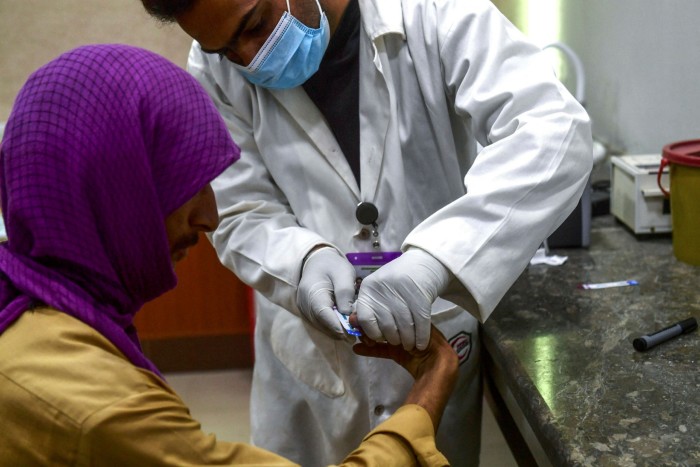HIV treatments advance but vaccine remains ‘a long way off’

Roula Khalaf, Editor of the FT, selects her favourite stories in this weekly newsletter.
In the Detroit hospital where Kimberly Smith worked as a doctor, there was a red door. Behind the door, hidden from public view, was the Aids ward.
Doctors and hospital workers would “gown up” and do “pretty substantial things to protect themselves”, to care for patients and bring meals into the ward, she recalls. Patients “deteriorated so rapidly . . . it was a lonely death, a lot of these were young gay men”. In some cases, they had been ostracised by their families.
HIV was identified more than 40 years ago; it has infected nearly 80m people since the epidemic began and killed more than 36m, according to UNAids, which is spearheading a global effort to halt Aids as a public health threat by 2030.
Substantial progress has been made in therapeutics and preventive approaches: pre-exposure prophylaxis, or PrEP, almost fully cuts the risk of catching the virus that can cause Aids. Post-exposure prophylaxis, or PEP, can help reduce the risk of infection if taken quickly enough after a potential exposure. And pervasive testing helps identify positive cases quickly.

HIV-positive individuals on effective treatment can live healthy lives and not pass the virus on.
A vaccine still does not exist, however, and curing patients has only been possible in a handful of specific cases, where other conditions changed the risk-benefit ratio in carrying out complex and risky procedures that are not otherwise recommended for healthy people living with HIV.
However, new potential treatments are in the pipeline.
Seeing the plight of HIV patients in the 1980s and early 1990s pushed Smith to pursue a career in infectious diseases, focusing on HIV. She is now head of R&D at ViiV Healthcare, an HIV-focused pharmaceuticals company majority-owned by GlaxoSmithKline with Pfizer and Shionogi as shareholders.
“The stigma from HIV was horrible then and continues to be horrible now, not to the same degree, but that really grabbed me,” she explains. “I wanted to do something, I wanted to make [patients] feel like someone cares about them, someone who’s not afraid to touch them.”
One of the interventions observers are most hopeful about is the advent of long-acting therapies, which require injection once a month or, potentially, even less frequently.
One of these drugs, called cabotegravir, is made by ViiV, which has submitted data to the US Food and Drug Administration for approval. The company hopes it will be used widely for prevention, given it is easier to take, more effective than the current standard of care and needs to be administered less frequently.

Smith recalls a conversation last summer with an HIV-positive friend she’s known for 30 years. “He asked me what’s new with work and I said, ‘We’re soon going to launch a treatment and prevention [drug] where you take it every month or every two months’, and he started to cry,” she says.
“Of course, then I started to cry, and we sat there crying, talking about how incredible it is from where we’ve been, and how life-changing that is for someone to not have to think about [taking drugs] every day.”
Nevertheless, we’re “very far away” from an HIV jab. Recently, a Johnson & Johnson study on a vaccine was stopped because it was not efficacious enough.
“Eighteen months into the Covid pandemic and we have a vaccine”, Smith says, but she points out that developing a similarly effective treatment for HIV is proving challenging four decades on, because the virus is “different . . . sneaky, it comes in, it attacks immune cells and hides in immune cells”. HIV also has many more mutations that can be difficult to control.

One approach has focused on latency-reversing agents — or medicines that will “turn on” the hidden viral reservoir in patients so that drugs can recognise it and suppress it for good. People living with HIV normally take a cocktail of drugs that prevents the virus from replicating and mutating, but, without adherence to effective treatment, there is a risk the virus eventually becomes resistant to pharmaceutical compounds.*
Drugmakers have often been accused of gouging prices on HIV treatments. But Smith pushes back on this, saying: “We have a clear, comprehensive access policy; we want to make our medicines accessible to people” in high-prevalence settings. She adds that the drugmaker has agreements in place with generics manufacturers to do this.
More stories from this report
Covid raises bar for infectious disease crisis response
Covid spurs expansion of public healthcare
Governments fall behind in race to stem antimicrobial resistance
Covid provides fresh impetus to tackle global obesity
Covid mission a shot in the arm for vaccine industry
Long Covid researchers work ‘round the clock’ to solve the puzzle
How data can help prepare us for the next pandemic
Controversial virus research sparks political debate in US
Budget cuts hinder efforts to eliminate neglected tropical diseases
Climate change threatens to reverse progress in beating malaria
HIV, as with Covid, has revealed the faultlines in society where vulnerable and marginalised groups are most at risk of disease. Yet the amount of testing and follow-up care has decreased for some patients, partly due to Covid-related disruption, according to UNAids — potentially worsening the situation in coming years.
Smith says the world should “recognise the potential [of Covid] for a disproportionate impact on communities of colour and poor communities, who are more likely to be frontline workers”.
“Not getting on top of [this differential impact] was a big error” early on in the pandemic, she adds — a lesson that authorities failed to learn from the HIV epidemic.
“I can’t do it my whole career and not let it be personal,” Smith says.
*A previous version of this article misstated that HIV eventually becomes resistant to pharmaceutical intervention. This has since been amended.
Comments